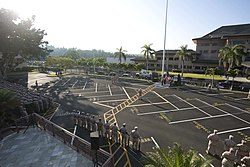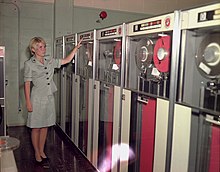Camp H. M. Smith
| Camp H. M. Smith | |
|---|---|
 Commandant of the Marine Corps Gen. Joseph Dunford and Sergeant Major of the Marine Corps Sgt. Maj. Ronald L. Green visit Camp H.M. Smith in 2015 | |
| Coordinates | 21°23′09″N 157°54′23″W / 21.38583°N 157.90639°W |
| Area | 220 acres (0.89 km2) |
| Site information | |
| Owner | United States Department of Defense |
| Garrison information | |
| Garrison | |
Camp H. M. Smith is a United States Marine Corps installation in the Halawa census-designated place on the island of Oahu, Hawaii,[1] near the community of Halawa (ha-LA-va) Heights. It is the headquarters of the United States Indo-Pacific Command (INDOPACOM), Special Operations Command Pacific, and Marine Forces Pacific, the Marine service component command of INDOPACOM.
The camp, originally the Aiea Naval Hospital, was named for General Holland McTyeire Smith, the first commanding general of Fleet Marine Force Pacific, on June 8, 1955. The initials H. M. also stood for his nickname which was "Howling Mad" referring to his temper and given to him by his Marines.
History


An Act of Congress on 17 March 1941 had approved purchase of the site, then a sugar cane field, for a Navy Hospital. In 1941, the investment for the 220½ acres of Camp Smith land, in fee simple (a term for owning both the land and the buildings), was $912,000, and improvements cost an additional $14 million. Work commenced in July and progressed slowly. Following the attack on Pearl Harbor on December 7, construction of the planned 1,650-bed facility was rushed to completion. With Admiral Chester W. Nimitz in attendance, the hospital was commissioned on November 11, 1942, but continued expansion was necessary.
Throughout World War II, the Aiea Naval Hospital served as a stopping off place for thousands of wounded sailors and Marines on their way home from the war in the Pacific. Hospital activity peaked following the battle for Iwo Jima in February and March, 1945, when 5,676 patients received medical care simultaneously.
On June 1, 1949, the hospital was deactivated and Army and Navy medical facilities were consolidated at what is now the Tripler Army Medical Center. In 1950, the Territory of Hawaii began negotiations to obtain the Aiea facility for a tuberculosis sanitarium.
In 1955, however, the Marine Corps selected the site as the home of the Fleet Marine Force Pacific. The first Marines took up residence in October 1955; the headquarters staff placed the camp in full operation just two weeks before its dedication on January 31, 1956.
In October 1957, Camp Smith also became the headquarters for the Commander in Chief, U.S. Pacific Command, who formerly shared the headquarters of the Commander in Chief, U.S. Pacific Fleet at Makalapa, near Pearl Harbor. Both commands were headed by the same officer until 13 January 1958, when a separate officer was named to serve as Commander in Chief, Pacific Fleet. In July 1992, FMFPac was further designated as the component command, Marine Forces Pacific. In April 1994, Marine Corps Base Hawaii assumed operational responsibility for Camp H. M. Smith.
Camp Smith today consists of 220 acres (0.89 km2) at Camp Smith proper, 137 acres (0.55 km2) at Puuloa Rifle Range in Ewa Beach, and 62 acres (250,000 m2) in Manana Housing. Camp Smith is unique in that it is the only Marine Corps installation that supports a unified commander, Commander, Indo-Pacific Command (CDRUSINDOPACOM).[2]
References
- ^ "2020 CENSUS - CENSUS BLOCK MAP: Halawa CDP, HI" (PDF). U.S. Census Bureau. Retrieved 2023-07-01.
Cp H M Smith
- 2010 map, 2000 map - ^ In symbolic nod to India, U.S. Pacific Command changes name. Retrieved 30 May 2018.
 This article incorporates public domain material from the United States Government
This article incorporates public domain material from the United States Government
External links
- Official USMC History of Camp Smith
- Historic American Buildings Survey (HABS) No. HI-524, "Camp H.M. Smith and Navy Public Works Center Manana Title VII (Capehart) Housing, Intersection of Acacia Road and Brich Circle, Pearl City, Honolulu County, HI", 40 photos, 31 data pages, 5 photo caption pages
- HABS No. HI-524-A, "Camp H.M. Smith and Navy Public Works Center Manana Title VII (Capehart) Housing, U-shaped two-bedroom duplex Type 1, Acacia Road, Birch Circle, and Cedar Drive, Pearl City, Honolulu County, HI", 20 photos, 12 data pages, 3 photo caption pages
- HABS No. HI-524-B, "Camp H.M. Smith and Navy Public Works Center Manana Title VII (Capehart) Housing, U-shaped three-bedroon duplex Type 2, Acacia Road, Birch Circle, and Cedar Drive, Pearl City, Honolulu County, HI", 20 photos, 12 data pages, 3 photo caption pages
- HABS No. HI-524-C, "Camp H.M. Smith and Navy Public Works Center Manana Title VII (Capehart) Housing, U-shaped three-bedroon duplex Type 3, Acacia Road, Birch Circle, and Cedar Drive, Pearl City, Honolulu County, HI", 19 photos, 12 data pages, 3 photo caption pages
- HABS No. HI-524-D, "Camp H.M. Smith and Navy Public Works Center Manana Title VII (Capehart) Housing, U-shaped three-bedroon duplex Type 4, Acacia Road, Birch Circle, Cedar Drive and Elm Drive, Pearl City, Honolulu County, HI", 15 photos, 12 data pages, 3 photo caption pages
- HABS No. HI-524-E, "Camp H.M. Smith and Navy Public Works Center Manana Title VII (Capehart) Housing, M-shaped four-bedroon duplex Type 5, Birch Circle, Cedar Drive, Pearl City, Honolulu County, HI", 19 photos, 12 data pages, 3 photo caption pages
- HABS No. HI-524-F, "Camp H.M. Smith and Navy Public Works Center Manana Title VII (Capehart) Housing, U-shaped four-bedroon duplex Type 6, Birch Circle, Elm Drive, Elm Circle, and Date Drive, Pearl City, Honolulu County, HI", 19 photos, 10 data pages, 3 photo caption pages
- HABS No. HI-524-G, "Camp H.M. Smith and Navy Public Works Center Manana Title VII (Capehart) Housing, three-bedroon single-family type 7, Birch Circle, Elm Drive, Elm Circle, and Date Drive, Pearl City, Honolulu County, HI", 18 photos, 10 data pages, 3 photo caption pages
- HABS No. HI-524-H, "Camp H.M. Smith and Navy Public Works Center Manana Title VII (Capehart) Housing, three-bedroon single-family type 9, Birch Circle, Elm Drive, Elm Circle, and Date Drive, Pearl City, Honolulu County, HI", 19 photos, 10 data pages, 3 photo caption pages
- HABS No. HI-524-I, "Camp H.M. Smith and Navy Public Works Center Manana Title VII (Capehart) Housing, four-bedroon single-family type 10, Birch Circle, Elm Drive, Elm Circle, and Date Drive, Pearl City, Honolulu County, HI", 20 photos, 11 data pages, 3 photo caption pages
- HABS No. HI-524-J, "Camp H.M. Smith and Navy Public Works Center Manana Title VII (Capehart) Housing, three-bedroon single-family types 8 and 11, Birch Circle, Elm Drive, Elm Circle, and Date Drive, Pearl City, Honolulu County, HI", 19 photos, 12 data pages, 3 photo caption pages


